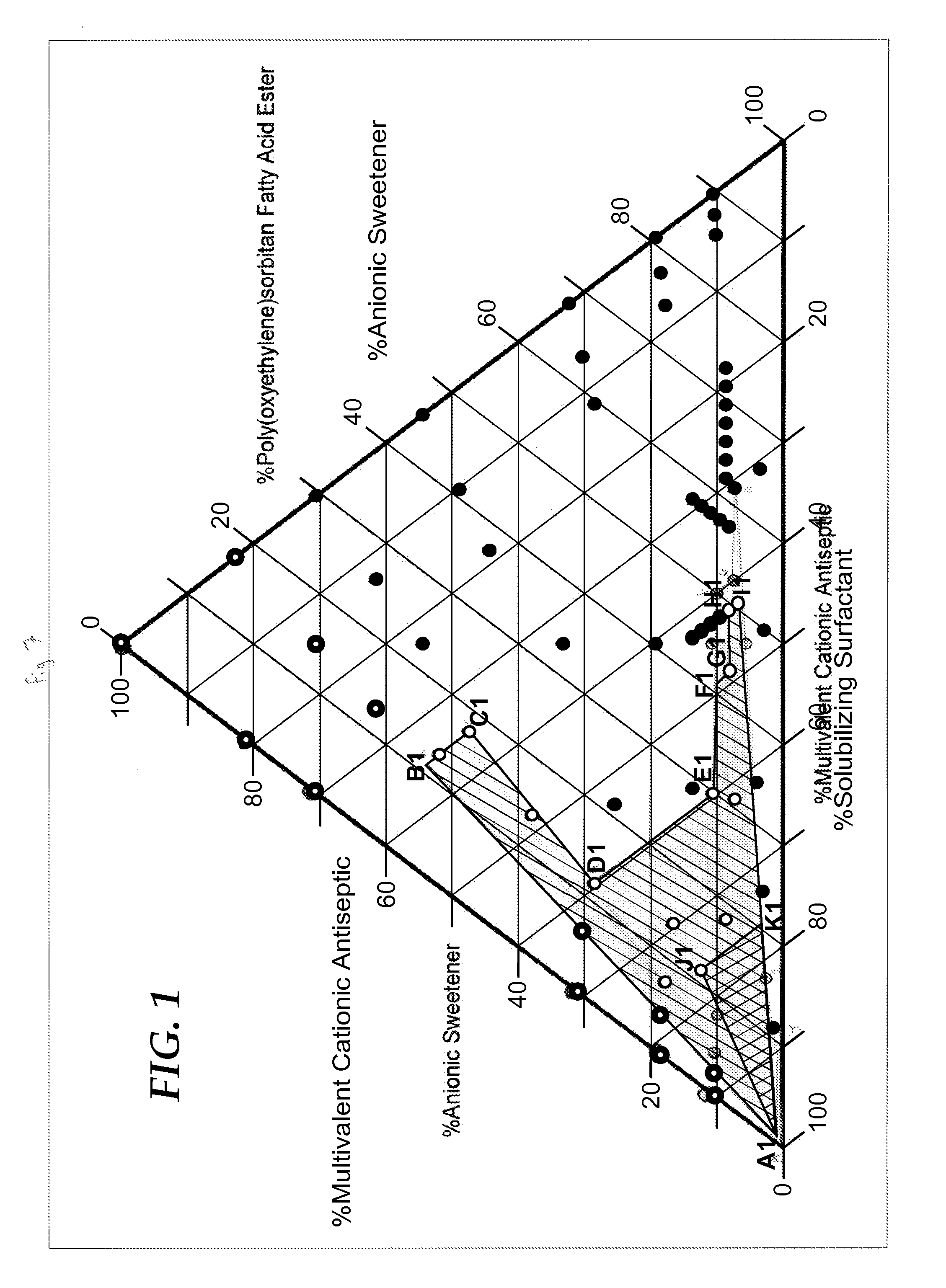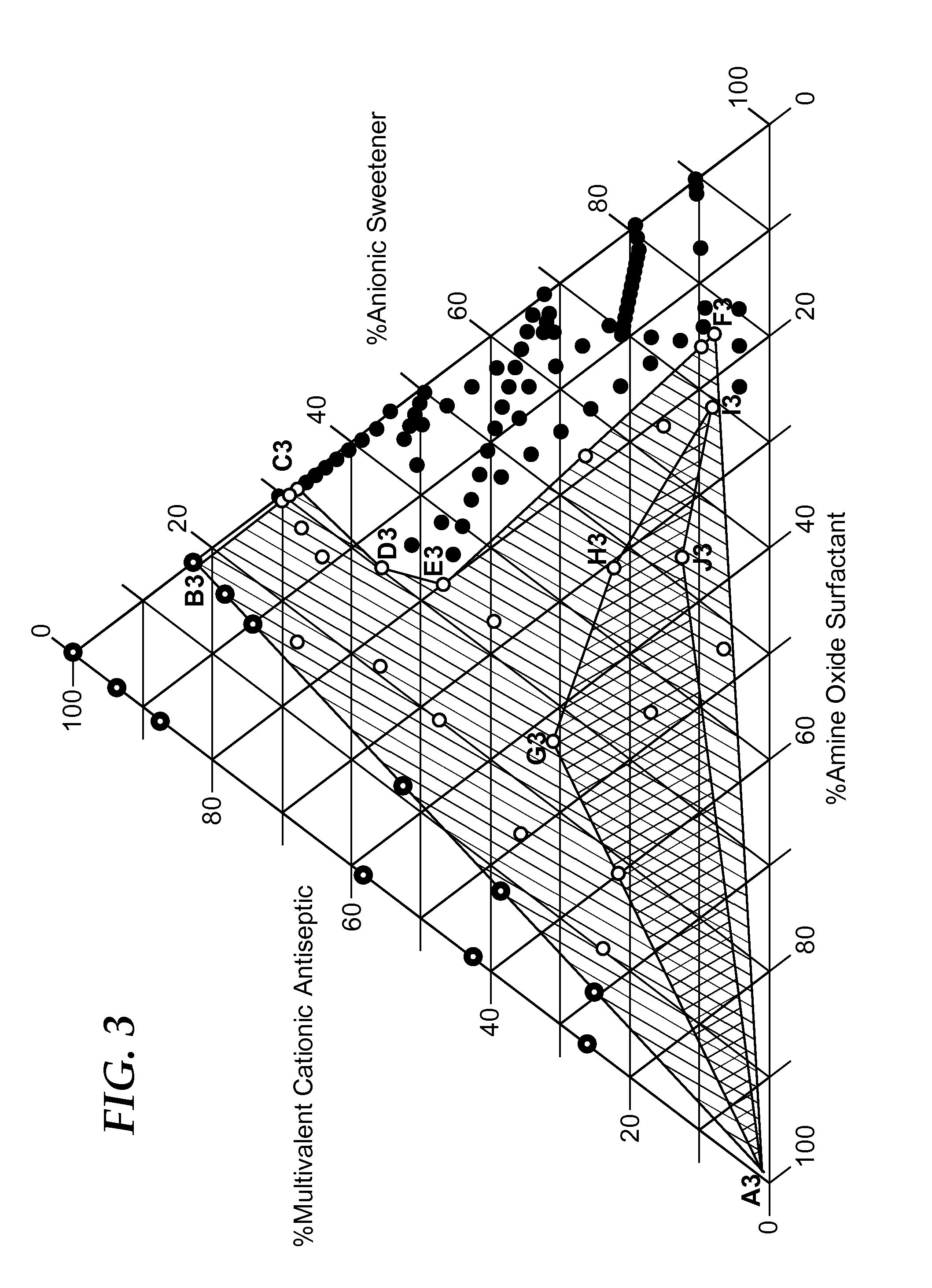Cationic antiseptic compositions
a technology of cationic antiseptic and composition, which is applied in the field of cationic antiseptic composition, can solve the problems that the precipitation of anionic compounds is particularly destructive to the antimicrobial activity of multivalent cationic antiseptics, and achieves the effect of preventing the inactivation of antiseptics and destroying antimicrobial activity
- Summary
- Abstract
- Description
- Claims
- Application Information
AI Technical Summary
Benefits of technology
Problems solved by technology
Method used
Image
Examples
example components
[0258]
Trade Name / AbbreviationDescriptionSourceLocationSURFACTANTSAMMONYXLaurylamidopropyldimethylamineStepanNorthfield,LMDOoxide; 33 wt. % activeCompanyIL, USA(an amine oxide surfactant)BRIJ 78poly(oxyethylene) 20 octadecyl etherSigma-AldrichMilwaukee,(a micelle-forming nonionic surfactant)CompanyWI, USACANARCEL TWPoly(oxyethylene) 40 sorbitanKraft ChemicalMelrose Park,62diisostearateCompanyIL, USA(a micelle-forming nonionic surfactant)DECAGLYN 1MPolyglyceryl-10 MyristateBarnetEnglewood(a micelle-forming nonionic surfactant)Products CorpCliffs, NJ,USAGLUCOPON(C8-C10) fatty alcohol ether of monoBASFFlorham225DKand oligoglucopyranosides;CorporationPark, NJ,70 wt. % activesUSA(a micelle-forming nonionic surfactant)TRITONPolyethylene glycol p-(1,1,3,3-DOW-UnionDanbury, CT,X-100tetramethylbutyl)-phenyletherCarbide CorpUSA(a micelle-forming nonionic surfactant)PLANTACAREAlkylpolyglucosidesCognisCincinnati,818 UP(a micelle-forming nonionic surfactant)OH, USATRYLOX5906(CO-30) POE(30) Ethoxy...
example 1
[0270]The following samples of Example 1 were prepared and tested as described above in TEST METHOD A—PRECIPITATION TEST and the TEST METHOD B—ANTIMICROBIAL EFFICACY TEST. For each sample a “placebo” was also prepared in similar fashion using the same stock solution of sodium saccharin and surfactant from STEPS 1-2 except water was substituted for CHG solution. No precipitate was observed in the placebos. It was observed that solutions prepared with final concentrations of 0.2% sodium saccharin and 0.12% CHG, but without surfactant resulted in precipitation. Example 1 was conducted to demonstrate the addition of the appropriate surfactant will prevent that precipitation. Before the addition of CHG in STEP 4 of the samples of Example 1, all solutions were clear and free of precipitate. Samples were observed for precipitation (PPT) initially, which was immediately after the CHG was added and then again later, 30 minutes after the CHG was added.
TABLE 1EXAMPLE 1SodiumCHGSaccharinSurfact...
examples 2a-2c
[0271]The following samples of Example 2 were prepared and tested as described above in TEST METHOD A—PRECIPITATION TEST to evaluate a range of concentrations of the surfactant CANARCEL and precipitate causing anion, sodium saccharin in the presence of CHG at 0.06%, 0.12%, and 0.24%. Comparative examples designated with the suffix: C1, C2, C3, etc., are those in which precipitation DOES NOT occur because there is not enough sodium saccharin to cause precipitation with the CHG or are comparative examples in which precipitation DOES occur because there is not enough surfactant (CANARCEL) to counteract the precipitating effect of the sodium saccharin.
TABLE 2AEXAMPLE 2ANaSaccharinCANARCELCHGPPTPPTEX. 2AFinal wt %Final wt %Final wt %Initialafter 1 hr.EX. 2A-C10.050.000.24nonoEX. 2A-C20.100.000.24yesyesEX. 2A-10.100.050.24nonoEX. 2A-20.100.100.24nonoEX. 2A-30.102.000.24nonoEX. 2A-C30.200.050.24yesyesEX. 2A-C40.200.100.24yesyesEX. 2A-40.200.500.24nonoEX. 2A-50.202.000.24nonoEX. 2A-C50.500....
PUM
| Property | Measurement | Unit |
|---|---|---|
| Temperature | aaaaa | aaaaa |
| Fraction | aaaaa | aaaaa |
| Fraction | aaaaa | aaaaa |
Abstract
Description
Claims
Application Information
 Login to View More
Login to View More - R&D
- Intellectual Property
- Life Sciences
- Materials
- Tech Scout
- Unparalleled Data Quality
- Higher Quality Content
- 60% Fewer Hallucinations
Browse by: Latest US Patents, China's latest patents, Technical Efficacy Thesaurus, Application Domain, Technology Topic, Popular Technical Reports.
© 2025 PatSnap. All rights reserved.Legal|Privacy policy|Modern Slavery Act Transparency Statement|Sitemap|About US| Contact US: help@patsnap.com



